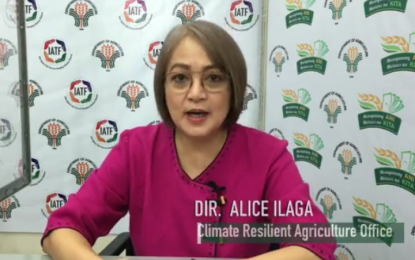News
DA pushes for ‘climate resilient’ programs

CLIMATE RESILIENT AGRI. The Department of Agriculture, on Tuesday (Nov. 17, 2020), urged local government units to invest in new practices or technologies in agriculture that ensure food security when natural calamities strike. DA Director for climate-resilient agriculture Alice Ilaga said their Adaptation and Mitigation Initiative in Agriculture (AMIA) program needs more promotion so it can reach more stakeholders. (Screengrabbed from DA’s virtual presser via PNA)
MANILA – The Department of Agriculture (DA) urges stakeholders to engage in promoting climate resiliency programs among farmers and fisherfolk to avoid more damage and losses in agricultural products when natural calamities strike.
In a virtual press briefing on Tuesday, DA Director for Climate Resilient Agriculture Office Alice Ilaga said the agency actually has an Adaptation and Mitigation Initiative in Agriculture (AMIA) program to push for climate-resilient agriculture.
“Ang mga regional offices natin ay marunong nang magbigay ng early warning o advance na abiso base sa weather o climate forecast. (The regional offices already know how to disseminate early warnings or advanced advisories on weather forecast),” she said.
DA Assistant Secretary Noel Reyes said through the early advisories, the affected farmers and fisherfolk were able to harvest early and save more than PHP30 billion worth of produce.
AMIA is the flagship program of DA for climate change adaptation and mitigation. The country’s agriculture and fisheries sector would enable local communities to manage climate risks while pursuing sustainable livelihood vision climate-resilient agriculture (CRA), the agency briefed.
However, she admitted the need to inform more people in the industry of it.
“The AMIA villages are piloted only in selected barangays,” she said.
Reyes explained this means effort is needed to promote AMIA technologies and practices.
“This shall be accomplished by strengthening partnership with the local government units (LGUs) and with farmers’ groups, cooperatives, and associations. Even the private sector and non-government organizations should share their resources and expertise,” he said in a text message to Philippine News Agency.
The LGUs should invest in more climate-proof structures such as warehouses that are put in higher elevations so when a flood comes the food stored inside will still be utilized, Reyes added.

In her presentation, Ilaga shared AMIA incorporates the national color-coded agricultural guide (NCCAG) maps which are accessible publicly at www.farmersguidemap.gov.ph.
The NCCAG is composed of 20 agricultural maps that identify naturally suitable and economically important crops, she said.
It also overlays with eight climate change-induced hazards. These maps are vital to crop growth and survivability such as water availability and climate data.
Apart from it, AMIA also conducts an information drive that aims to update the stakeholders on weather and climate information.
“We teach them to diversify crops, have multi-commodity in crops and livestock. Value-adding is also vital. This way, the farmers always have another option when one crop is devastated,” she said in vernacular.
Early this year, Agriculture Secretary William Dar ordered the expansion and upscaling of AMIA’s strategy to the municipal, provincial and regional levels to test climate-resilient agriculture programs.
“We need science-based and evidence-based options and actions that we can easily provide to all our stakeholders. The creation of more AMIA villages is one of the strategies that the DA is adopting to address the challenges of climate change,” he said.
AMIA villages are where climate-resilient agricultural pilot programs are tested. Data collected from these villages will be used for scaling-up in areas with compatible profiles.
As per DA’s latest advisory on Wednesday (Nov. 18), the total damage and losses incurred due to Typhoon Ulysses have increased to PHP3.84 billion affecting 104,733 farmers and fisherfolk.
The secretary mentioned they have so far released more than PHP2.2 billion worth of assistance to the affected farmers and fisherfolk.
Dar said the DA is going to distribute hybrid rice seeds, inbred rice seeds, fertilizers, hybrid corn seeds, assorted vegetable seeds, including livestock such as poultry, goats, and ducks to kickstart the rehabilitation of the ruined croplands.
He said Cagayan province will get PHP846 million while Isabela will receive PHP986 million, noting that more agricultural areas were damaged after Typhoon Quinta and Super Typhoon Rolly passed the province.
Nueva Vizcaya is set to receive PHP148 million while the province of Quirino, still a part of the Cagayan Valley Region, will be given PHP96 million.
Apart from the financial assistance and farming starter kits, the National Food Authority (NFA) has also allocated PHP41 million worth of rice for distribution to typhoon victims.





















